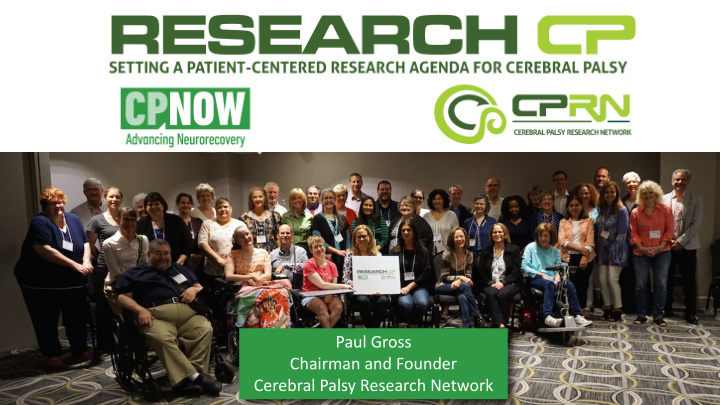



Paul Gross Chairman and Founder Cerebral Palsy Research Network 1
Cerebral Palsy Research Network Founding • NIH Workshop on cerebral palsy in November 2014 Key Takeaways 1. Start a national CP registry 2. Pursue Comparative Effectiveness Research question 3. Increase the study of adults 4. Bring more young clinician scientists into the field 5. Advance basic and translational science for CP • CPRN founded to do 1-4 • Merger of two core experiences: HCRN and Learn From Every Patient • Patient-centered from the outset 2
Research CP : Finding out what the patient community cares about • Research CP was conceived of to help CPRN and the greater research community focus its research efforts. • Parent advocates and adults with CP continue to struggle with decision making because of a lack of comparative research. • Communicate CP research priorities to medical professionals, granting agencies, government agencies and the insurance industry. 3
Research CP Objectives – PCORI Application 1. Educate patients, caregivers and clinicians via webinars 2. Survey the patient and provider on research priorities for CP 3. Convene a workshop to set a research agenda 4. Publish a whitepaper outlining the community’s shared comparative effectiveness and quality agenda for cerebral palsy. 4
Survey the patient and provider community • Codigital to generate, prioritize and refine ideas 5
What do adults with CP want to know? “My biggest challenge is understanding what is happening within my body. It appears over the last couple years that my muscle has deteriorated. I expected some deterioration, but not quite this early. I would like to determine if this is reversible or how much it will worsen.” -Russell Thompson 6
Why patient-centered research? “If our research aims to improve the lives of people with CP, it seems self-evident that we should understand in what way they want their lives improved. Partnering with people with CP and their carers, will inform the questions we ask, the methods and measures we use to answer them, and facilitate the means by which we can adopt or implement what will most benefit them.” -Unni Narayanan, MD 7
Common observations among participants • A desire to keep the momentum of the partnership moving forward. • Longitudinal studies across the age span and the clinical spectrum of CP should drive research. • The importance of the adult perspective including the cascading loss of function. • Emphasizing participation as an important outcome measure. 8
Limitations • Missing adolescent voice • Codigital favored broad topics over narrower topics relevant to smaller slice of participants • Selection bias common to social media targets • Results influenced by relative participation of different groups although consumers (parent, person with CP, advocate) contributed >60% 9
Genetic Causes of Cerebral Palsy • Funded by NINDS/NIH • Precision Medicine Initiative • CPRN sites will refer patients with unknown etiology • Combined power of genetic analysis and clinical description and follow up will open new vistas of understanding in CP—long term outcomes, treatment Michael Kruer, MD outcomes Phoenix Children’s Hospital 10
Key Takeaways • Create space and safety for patient / clinician researcher interaction • Plan for iterative process to overcome overly broad research ideas • Partner clinician researchers with a track record for funded research
Recommend
More recommend